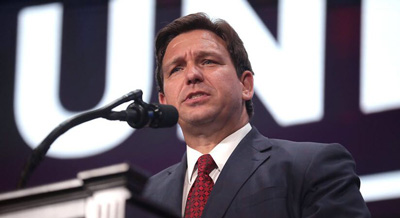Legal Tender, Lost Trust, and Lofty Forecasts: Why Now Is Gold’s Moment to Shine
Peter Reagan
 Florida passes “historic” legislation reinstating gold and silver as legal tender Florida passes “historic” legislation reinstating gold and silver as legal tender
Florida just became the second-biggest state to restore gold and silver as legal tender. Meanwhile, Germany’s central bank is suspicious of the Federal Reserve, and BofA analysts issue an eye-popping forecast. Is this the beginning of a global monetary realignment?
In our early pick for the story of the year, last week Florida Governor Ron DeSantis signed HB 999 into law, recognizing gold and silver as legal tender:
From defunding ESG to fighting de-banking, we’ve taken actions to protect Floridians from the push for more centralized control over currency and transactions. Today, I was pleased to sign HB 999, through which Florida will exercise its authority under the U.S. Constitution to… pic.twitter.com/MZpwbbHdC8
— Ron DeSantis (@GovRonDeSantis) May 27, 2025
While eleven other states have recognized gold and silver as legal tender to some degree, it’s usually limited to eliminating sales taxes on gold and silver bullion.
Florida is now the first state to… do what exactly? It feels strange to call this a historic move or some kind of landmark, when it is a positive regression.
Here are some of the things DeSantis had to say on the matter:
We are the first large state to step up and to get this done.
Well, that’s not exactly true. Texas took these steps back in 2017 – a couple of years after founding the first state-administered depository in U.S. history. And yes, Texas is much bigger than Florida. The Lone Star State boasts 30% greater population, 40% bigger GDP and 10 more electoral votes than the Sunshine State.
This is right out of the Constitution of the United States. This legislation will authorize money services businesses to accept gold and silver coins that meet specific purity standards.
Alas, federal legal tender laws overrule state-level legislation – so the only mandatory legal tender for all debts, public and private, will continue to be the federal reserve note.
Separately, in the X post above, DeSantis says:
HB 999 will give Floridians greater financial freedom and more tools to safeguard their hard-earned money. Moreover, this legislation supports inflation-proof assets, so Floridians' wealth is not at the whim of our federal government's reckless spending addiction.
Supporters say this is yet another step in defunding ESG, fighting de-banking and giving citizens a choice in their preferred currencies. Critics say it’s nothing more than following in the footsteps of the real sound money pioneers, like Utah and Texas…
Regardless, in practical terms, here’s what this means. Every licensed money services business (payments processors, check cashers, money transmitters, currency exchanges and so on) can implement gold and silver as payments options. Interestingly, because they’re regulated separately, banks are not considered to be money services businesses.
In practice, what does this mean? Well, considering that accepting gold and silver in payment is voluntary, not much. No business is required to accept gold and silver as payment.
As we can see at the Tenth Amendment Center, New Hampshire is another of those 11 states whose residents can transact in gold and silver (even though it isn't recognized as legal tender).
So what’s next? Quoting from the press release:
Practically speaking, this would allow Florida residents to use gold or silver as money rather than as mere investment vehicles.
The passage of H999 would represent a big first step against the fiat-based Federal Reserve system by creating a foundation to pull the rug out from under it on the state and local levels. In essence, it would set the stage for the people themselves to undermine the Federal Reserve monopoly by introducing competition into the monetary system.
The next step would be for people to start taking advantage of the status of gold and silver as money by usingboth as such instead of Federal Reserve notes.
Are online payments processors going to have gold and silver as an alternative currency for payment (like crypto)? Will Florida build its own state depository, perhaps even issue its own state-backed, fully-redeemable currency? Paying for your groceries with Goldbacks? A Florida silver dollar?
Well, it’s certainly possible… But remember, most people are delighted to be paid in gold and silver – but they’re a lot more hesitant, generally, to spend their gold and silver.
Having said that, the Florida law did take a novel step that none of the other sound-money states have so far. They reintroduced the gold clause in contract law:
The principle behind a gold clause contract is simple. It requires that payment be made in a specific amount of gold or its paper equivalent. For example, a mortgage might stipulate that repayment must be in the form of 30 ounces of gold. Gold clauses protect the parties to a contract from currency debasement and incentivize the use of sound money.
Look at that! A simple tweak to the law protects both debtors and creditors from inflation. What a great idea!
Dear reader, you should remember that this “great idea” was unnecessary when our nation used sound money. Under the gold standard, there’s no difference between some number of dollars and some other weight of gold. They’re the same thing.
In order for Florida to become a bastion of sound money, the state would need its own bullion depository for exchanging of digital or paper gold and silver vouchers into bullion. Sort of how the U.S. dollar used to function, the pre-1957 U.S. Treasury “silver certificates” that were exchangeable for silver coins.
This is definitely a development to be watched across years. In a way, it’s a homegrown version of the Rio Reset. The frustrations are the same – purchasing power destruction, the monopoly on currency and a lack of alternatives. And the solution is the same, as well – replacing the current, broken solution with a historic, time-tested and reliable replacement.
I believe we’re seeing the very first stages of the much-anticipated battle between governments (at the national and state levels) and the Federal Reserve over the future of money. Florida’s legislature has already outlawed the use of a federal central bank digital currency (CBDC). That, plus this new legal tender laws, are both steps in the right direction!
The ultimate destination is, of course, monetary sovereignty. Economic freedom. And that’s a destination well worth the trip.
Why are the Germans suddenly worried about their Fed-custodied gold reserve?
One of the strangest stories of the last few days had the following headline:
Trump spurs questions about safety of Germany's gold in New York
Why?
…well, that’s not exactly clear. (Presumably it’s rude to ask for details.)
Apparently, both Germany's left and right parties are claiming that Trump's "erratic" behavior might change how foreign gold reserves are treated. The claim is made that President Trump wants to control the Federal Reserve. As if the Fed has been an apolitical, neutral entity we can reliably trust to safeguard the value of our money.
Well, the half of the value of our money remaining since the turn of the century:
…but this isn’t about the dollar! It’s about Germany’s gold. Trump’s frequent and scathing criticism of the Fed is being twisted into such claims as:
"Trump wants to control the Fed, which would also mean controlling the German gold reserves in the U.S.," said Michael Jaeger, the vice-president of Germany's Taxpayers Federation.
"It's our money, it should be brought back."
The Bundesbank has the world's second largest (official) central bank gold reserve of 3,352 metric tons. One-third of the total sits in the basement of the Federal Reserve Bank of New York, and has for the last 60 years. In the wake of the Great Financial Crisis, Germany had 300 tons of gold shipped back home from New York, and another 374 tons from Paris to “build confidence at home.”
The repatriation went smoothly from 2014-2017 and even wrapped up three years ahead of schedule! Today, about half of Germany’s gold reserves are stored in Frankfurt (the rest are in London and New York).
So what changed? Nothing! Well, the man sitting in the White House did – from Obama to Trump, to Biden back to Trump… So now Germany wants the rest of its gold back from the U.S. because of Trump’s “erratic” behavior?
Friends, I don’t buy it.
On the other hand, there have been ongoing rumors and questions regarding the Fed’s custody of gold reserves, whether that gold has been leased or loaned or otherwise “encumbered” in a financial sense. That’s a question worth answering! But it’s not a question that any sitting President can answer.
The real issue, I believe, is the sanctity of custody. When Biden, Yellen and NATO first froze, then seized Russia’s sovereign wealth fund? That act set off shockwaves that are still rattling central bankers around the world.
This is why central banks have been buying historic record quantities of gold annually for the last three years. (And storing it domestically.)
It’s an issue of trust. And trust, as we know all too well, is exceedingly difficult to earn – and all too easy to destroy.
Champion forecaster Bank of America's next target: $4,000 gold, $40 silver
Bank of America has been very accurate with its gold forecasts, hitting both the $3,000 and $3,500 targets on the mark.
So, when we hear them call for $4,000 gold next, we are inclined to listen.
"We've been calling for $3,500 gold for the first half of this year," said Francisco Blanch, head of global commodity and derivatives research at Bank of America Securities.
We got there, and we feel the market's going through a correction right now that could last a few months. We're still bullish longer term.
…We think longer term, maybe into the second half or into 2026, we'll breach $4,000 per ounce, but we're going through a correction because some of the extreme uncertainty that we've witnessed in recent months seems to be fading.
Breaking $4,000 before the end of the year? Exciting news for gold investors.
But what of silver? The bank's forecast for $40 silver, which considers both investment and industrial demand, is satisfying. As we have stated many times, $40 and then $50 are the next real targets for silver.
But do you see the problem there? Even if silver does hit $40, we will still be left with a 100-to-1 gold to silver ratio, far above any historical norm or reason. (That's interesting since the bank does say that gold running off so strongly will partly enable silver to reach $40.)
But if that were the case and silver was following the price of gold, it should hit a minimum of $50 with a $4,000 gold price. Anything up to $100 would be fully within historical precedent.
The optimistic silver investor can still ask: "What happens in late 2026 and onwards?"
As has been the case for a very long time, something in the silver market has got to give. It's only a question of when – and, afterward, “How much higher?”

Peter Reagan is a seasoned financial market strategist at Birch Gold Group with over 15 years of experience in the precious metals industry. He has been featured in several leading publications, including Newsmax and Zerohedge. At Birch Gold Group, Peter leverages his deep market insights to help educate customers on how they can diversify their savings into gold and other precious metals. His commitment to education has made him a trusted thought leader in the field. In addition to the Birch Gold website, you can follow Peter on LinkedIn.
www.birchgold.com
| 

